A Waning Moon, two ZTF Comets and Plenty of Planets, and the Night’s Brightest Stars!
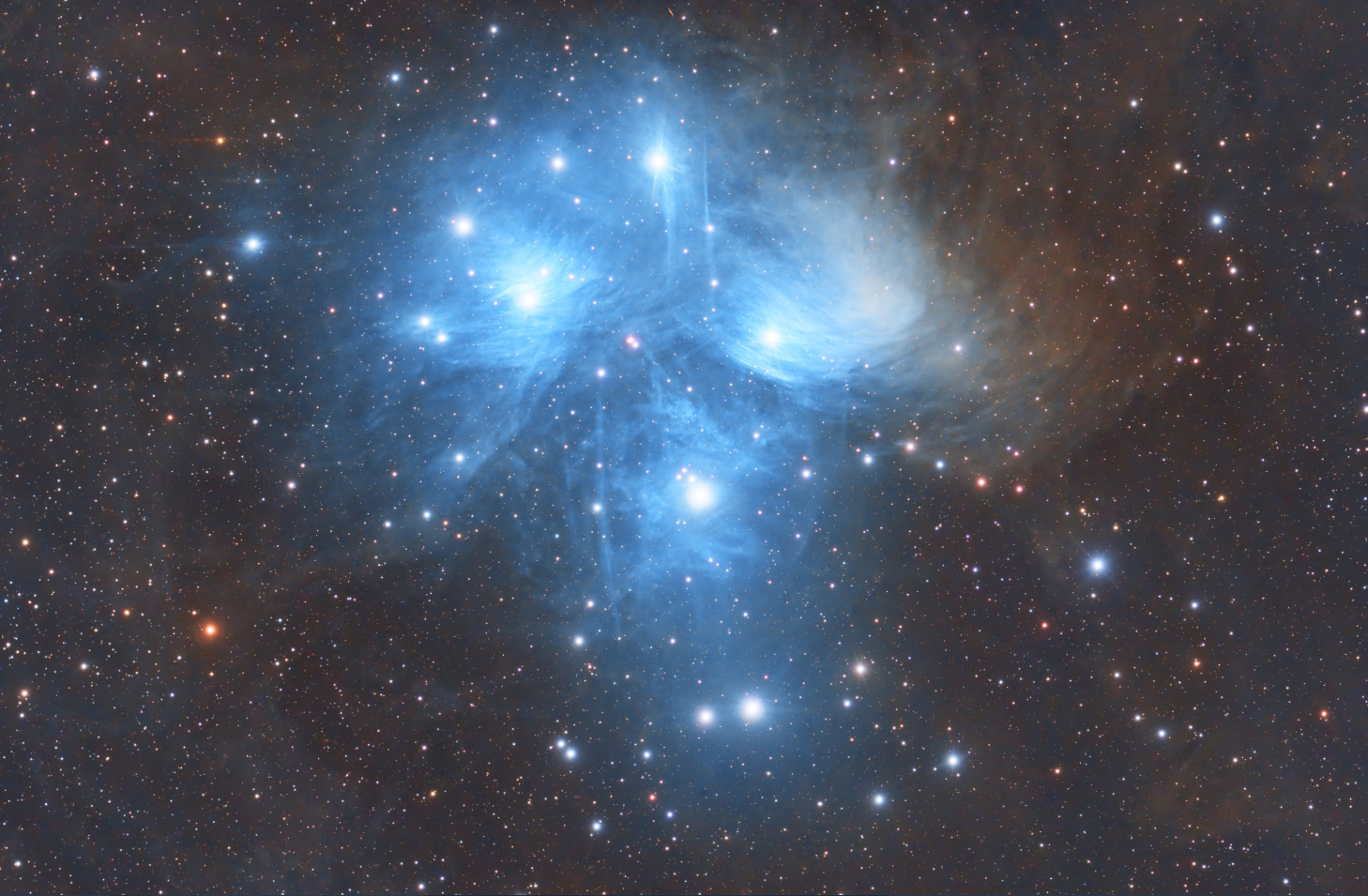
This spectacular image of the Pleiades Star Cluster (Messier 45) in Taurus was captured and processed by Shawn Nielsen of Kitchener, Ontario. Notice both the bright blues of reflection nebulosity and the darker dust in the background. Shawn posts his images on social media as @Visible Dark_ . His website https://visibledark.ca/ contains many more treasures. Have a look!
Hello, Early January Stargazers!
Here are your Astronomy Skylights for the week of January 8th, 2023 by Chris Vaughan. Feel free to pass this along to your friends and send me your comments, questions, and suggested topics. You can also follow me on Twitter as @astrogeoguy! Unless otherwise noted, all times are expressed in Eastern Time. To subscribe to these emails please click this MailChimp link.
If you’d like me to bring my Digital Starlab portable inflatable planetarium to your school or other daytime or evening event, or deliver a session online, contact me through AstroGeo.ca, and we’ll tour the Universe, or the Earth’s interior, together! My terrific book with John A. Read entitled 110 Things to See With a Telescope is a guide to viewing the deep sky objects in the Messier List – for both beginners and seasoned astronomers. DM me to order a signed copy!
The moon will wane in phase and rise later each night worldwide. That will improve our chances to see the pre-dawn comet C/2022 E3 (ZTF) and the evening comet C/2020 V2 (ZTF). Four bright planets stretch across the evening sky and Mercury has joined the morning sky. And I highlight all of the very bright stars that sparkle in winter time. Read on for your Skylights!
Comets Update
Two comets discovered by the robotic widefield camera of the Zwicky Transient Facility (or ZTF) on Mount Palomar in California are currently available for viewing.
Comet c/2022 E3 (ZTF) is predicted to become bright enough to see in binoculars, and possibly our unaided eyes, around February 1! At that time it will be passing nearest to the Earth – at a distance of 43 million km. The orbit of this comet is nearly perpendicular to the plane of our solar system. It is diving down (southward) through the plane of our solar system between the orbits of Earth and Mars. Comets normally display their largest coma (fuzzy head) and tail while they are nearest the sun. That perihelion event will happen on Thursday, January 12. You can view and play with Comet E3’s orbit in 3D here.
Comet E3 is already visible as a faint fuzzy patch in big binoculars and backyard telescopes under dark skies – but only during the pre-dawn hours. By the end of January, though, it will become circumpolar for Northern Hemisphere observers and visible between the Dippers during evening.
This week Comet E3 will be sliding northward in the constellation of Corona Borealis (the Northern Crown). The crown’s stars are situated halfway up the eastern pre-dawn sky, with the keystone shape of Hercules positioned to its lower left and the very bright star Arcturus sparkling to its upper right.

At latitudes near Toronto, the comet and Corona Borealis’ stars will clear the rooftops by about 2 am – but the best time to see the comet will be 4-6 am in your local time zone. That’s when it will be higher in the sky. On Monday morning, comet c/2022 E3 (ZTF) will sit to the upper left of the crown of stars, more or less between the medium-bright stars Eta Herculis and Thiba (or Delta Boötis). Each night this week, the comet will slide half a finger’s width farther from the crown, in the direction of Polaris.
The other ZTF comet, named C/2020 V2 (ZTF), will be observable during the evening this month – but you’ll need a telescope and a relatively dark location. This comet’s position near the north celestial pole means that only sky-watchers in the Northern Hemisphere can see it. The comet is currently a faint, magnitude 9.5 fuzzy spot in large binoculars, but should show relatively well in 80-mm and larger telescopes, especially as the moon wanes each night. Comet V2 passed closest to Earth last Thursday. It will remain at about the same brightness over the month as it dives through the plane of the solar system between the orbits of Mars and Jupiter. Its perihelion will be later this year. You can play with a nice interactive 3D model of its orbital path here.

This week comet V2 will be travelling celestial southward through northern portion of Cassiopeia (the Queen). Since the northern sky rolls around the celestial pole during the night, that motion translates to upwards during evening – away from Polaris and towards the higher, shallow “V” half of Cassiopeia.
Tonight (Sunday) the comet will be positioned about midway between Polaris and the star Ruchbah (or Delta Cassiopeiae). On each subsequent night it will shift almost a finger’s width closer to Ruchbah. (It will pass extremely close to Ruchbah on January 26!) At the moment there aren’t any bight stars near the comet to guide you, but it’ll pass several medium-bright ones. The comet is highest in the sky after dusk, and then it descends the northwestern sky during evening – so try to view it right after dinner. (Don’t forget to chill down your telescope, with its lens caps on, in a secure location for an hour or two ahead of viewing.)
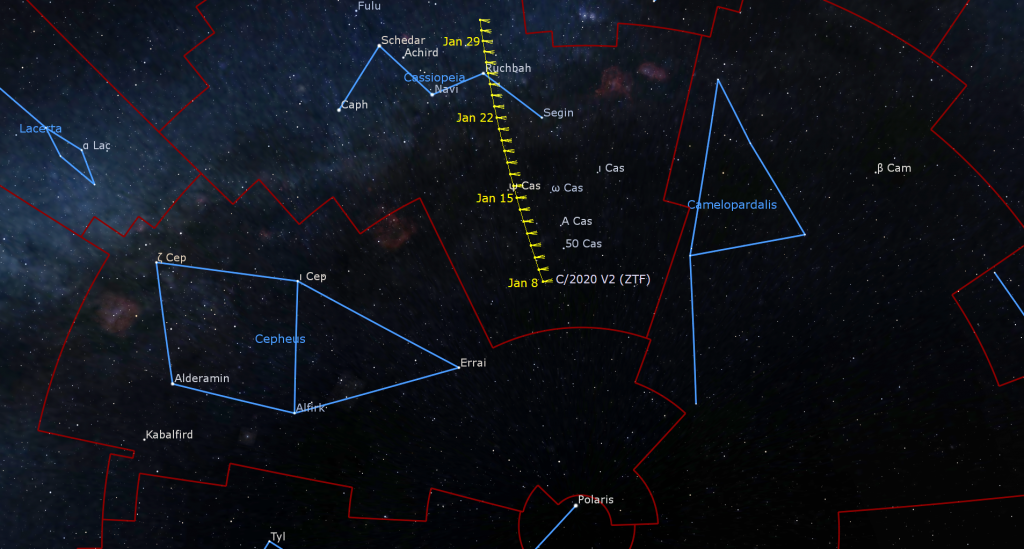
The Bright Stars of January
We’re deep into the cold (and hopefully, clear) nights of winter. Maybe it’s the crisp air, but winter’s stars seem to be the brightest stars. We also get to cheat a little because the three top stars of summer are still around in early evening. Here’s your guide to the brightest stars you can see with your unaided eyes (or binoculars) in the evening sky over the next month or so – even when the moon is around. I’ve put their rank (3rd brightest in the night sky, 7th, etc.) in brackets.
Let’s start in the western half of the sky because those stars set first. If you have an unobstructed southwestern horizon, look as soon as it’s dark for bright Fomalhaut (18th) in Piscis Austrinus (the Southern Fish) sitting just above the southwestern horizon. Turning directly west, the three bright corners of the Summer Triangle still shine brightly in the early evening. The lowest of the three is Altair (12th) in Aquila (the Eagle). A bit higher, and about 3.4 outstretched fist diameters to the right of Altair, is Vega (5th) in Lyra (the Lyre). Deneb (19th) sits above and between those two. All three are hot, bluish white stars. Deneb is the tail of Cygnus (the Swan), and you should be able to see the great bird flying head-down into the west – along the Milky Way. Altair and Vega set about 7:30 and 9 pm local time, respectively. Deneb sets much later – at about 1:15 am local time.
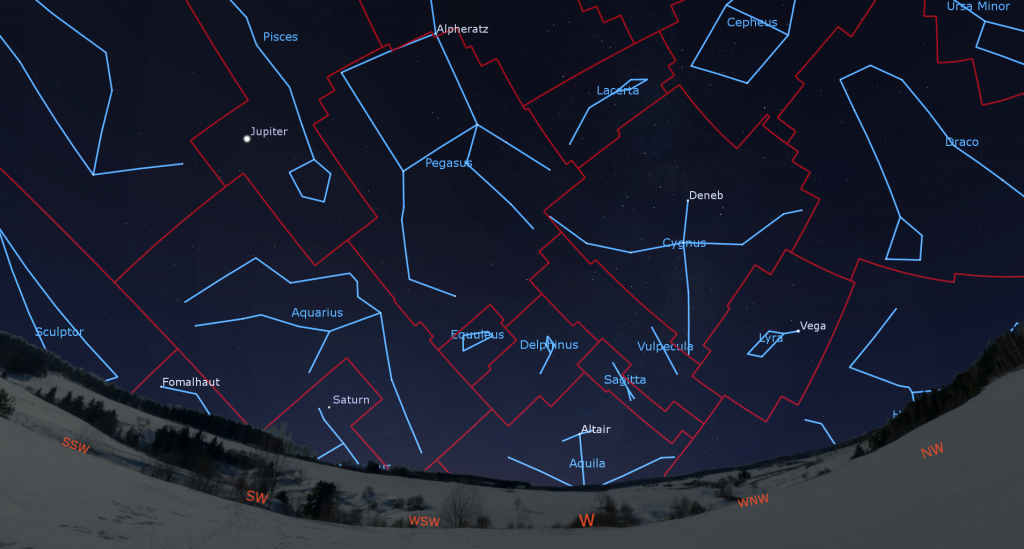
Next, turn fully around and look about halfway up the eastern sky. Bright yellowish Capella (6th) is on the left, with orange-ish Aldebaran (14th) located about three fist widths to the right of it. This winter, much brighter Mars is shining above and between them. Capella is the brightest star in the large oval constellation of Auriga (“Oar-EYE-gah”) (the Charioteer), while Aldebaran is the baleful red eye of Taurus (the Bull), whose triangular face is tilted sideways with his horns aimed down to the left. Both of these constellations will climb higher as the evening wears on.
The well-known constellation of Orion (the Hunter) sits directly below Aldebaran. His eastern shoulder is the old and bright reddish star Betelgeuse (11th), and his opposite foot is a bluish star of similar brightness named Rigel (7th). These two stars are hundreds of light-years away. Orion’s three-starred belt is a highlight of the winter sky. From east to west (lower left to upper right) they are Alnitak (30th), Alnilam (29th), and Mintaka (67th). The three stars are about evenly spaced – almost exactly 1.3° (about three moon diameters) apart. Orion’s other shoulder is marked by bluish white Bellatrix (26th), and his opposite foot is called Saiph (53rd).
To the left of Orion sits the zodiac constellation of Gemini (the Twins). Its brightest stars are yellowish Pollux (17th) and pale white Castor (23rd). Like many twins, they are a challenge to keep straight which is which. Castor, the higher star, rises first, just as “C” precedes “P” in the alphabet. Unlike identical twins, Castor is both fainter and whiter than Pollux. Gemini also hosts Alhena (43rd), the star that forms Pollux’ higher, western foot.
By about 8 pm local time the night sky’s brightest star will clear the trees in the sky below Orion. Sirius (1st) is also called the Dog Star because it resides in the constellation of Canis Major (the Large Dog). It is a very hot, bluish-white star, so bright because it is our neighbour – positioned “just up the street” at only 8.6 light-years away. Sirius has a reputation for twinkling vigorously with flashes of pure colour. This is because it sits fairly low in the sky for mid-northern latitude dwellers and they see it shining through a thicker blanket of refracting air. The big dog hosts three more bright stars, namely Adhara (22nd), Wezen (36th), and Mirzam (46th). They mark his rear leg, rump, and front paw, respectively.
Sirius’ bright little sibling Procyon (8th) sits 25° (2.5 fist widths) to the upper left, underneath Gemini, in the constellation of Canis Minor (the Little Dog). It, too, is relatively close to Earth.
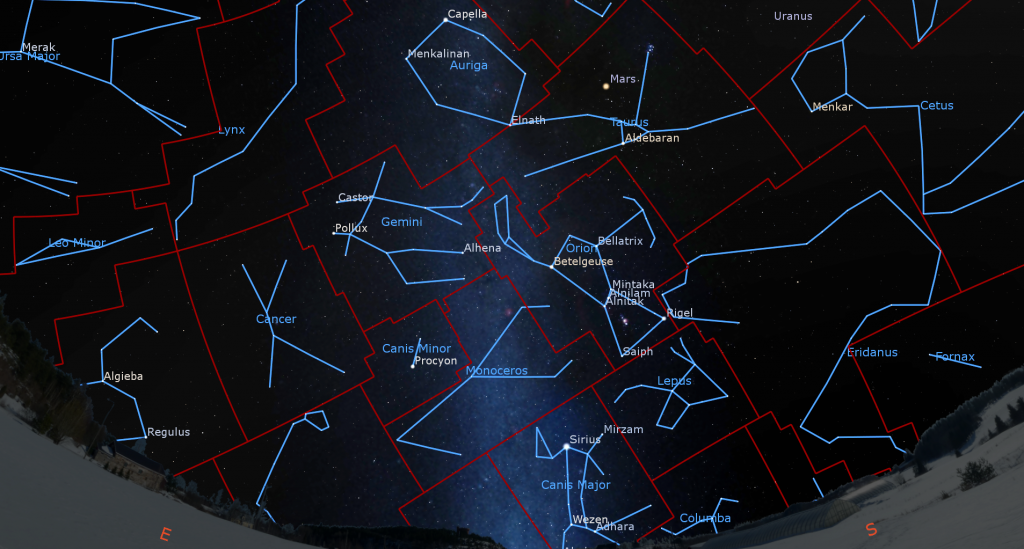
In late evening, the bright, white star Regulus (21st), the heart of Leo (the Lion) will rise to join the party.
So, which constellation wins the award for the brightest one? Of the top 50 stars, Orion has five and Canis Major has four. Does Sirius give Canis Major the win? I’ll let you decide. See how many of them you can learn!
The Moon
After Friday night’s Full Wolf Moon, our natural night-light will spend this week waning in illuminated phase and rising later – flooding the post-midnight sky worldwide with moonlight and then lingering into morning daylight as an echo of the night. You’ll still have several nights to check out the lunar features that dominate the moon’s illuminated western side. I described many of them last week here.
Tonight (Sunday) the bright, 95%-full moon will far outshine the muted stars of Cancer (the Crab) to its upper right. From Monday to Wednesday, the waning gibbous moon will slide through Leo (the Lion). Early risers on Tuesday can use binoculars to see the moon passing closely below (or celestial south of) the medium-bright star Al Jabbah (or Eta Leonis).
The moon will spend the rest of this week travelling the lengthy constellation of Virgo (the Maiden). On Friday morning, use those binoculars again to see the slightly gibbous moon shining a finger’s width to the upper right of the adjacent stars Zaniah (or Eta Virginis) and 13 Virginis. They mark her western elbow or shoulder, depending on the depiction you prefer.
The moon will officially reach its third quarter phase on Saturday, January 14 at 9:10 pm EST and 6:10 pm PST, which converts to 02:10 Greenwich Mean Time on Sunday. (Moon phases occur independently of Earth’s rotation.) The third (or last) quarter moon won’t rise until midnight local time. Then it will remain visible in the southern sky until late on Sunday morning. At third quarter, the moon is half-illuminated on its western side, towards the pre-dawn sun. Last quarter moons are positioned ahead of the Earth in our trip around the sun. About 3½ hours later, Earth will occupy that same location in space. The week of moonless evening skies that follow third quarter are ideal for observing winter’s deep sky targets in evening and the spring galaxies after midnight!
The Planets
Except for those in Antarctica, everyone on Earth can see four bright planets shining after sunset this week. For those at mid-Northern latitudes, Venus will appear as an extremely bright, star-like object above the southwestern horizon as the sky begins to darken after sunset. Venus will set about 90 minutes after the sun, slowly sliding to the lower right as dusk deepens. If the bright light you are seeing appears to be shifting left or right, through, it’s a plane. Keep searching!
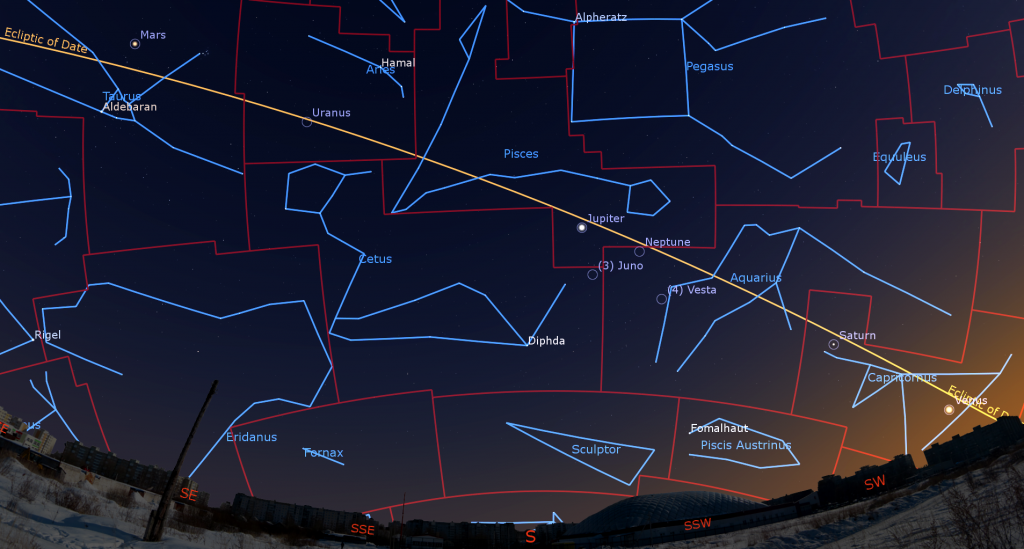
Be sure to wait until the sun has completely disappeared before searching for Venus in binoculars or telescopes. Our hot sister planet will show a 94%-illuminated disk in your telescope, but clear views will not be possible through so much intervening air. Since Venus is swinging away from the sun and climbing a bit higher each evening, we’ll enjoy clearer views of it with each passing week.
The other three bright planets will be strung along an arc spanning 120 degrees of the sky, with some fainter solar system denizens lurking between them. Tonight (Sunday), magnitude 0.8 Saturn will shine a fist’s diameter to the upper left (or 10° to the celestial northeast) of Venus. But Saturn’s yellowish speck, 74 times fainter than Venus, will need a darker sky before you can spot it. While Saturn and the stars are being carried sunward by the perspective change as we orbit the sun, Venus is moving in the opposite direction. The two planets will reduce their spacing to 8° next Sunday, and then the pair will kiss in a very tight conjunction a week after that.
When the sky darkens after about 6 pm local time, magnitude -3.85 Venus will prepare to set, and Saturn will be accompanied by the medium-bright tail stars of Capricornus (the Sea-Goat). Brighter Deneb Algedi will sparkle a thumb’s width to Saturn’s left (or celestial southeast) and half as bright Nashira will shine the same distance below them, completing a small triangle. Over the next weeks, you’ll be able to use binoculars, or your sharp eyes, to see Saturn’s easterly prograde motion shift the planet upwards and away from them.
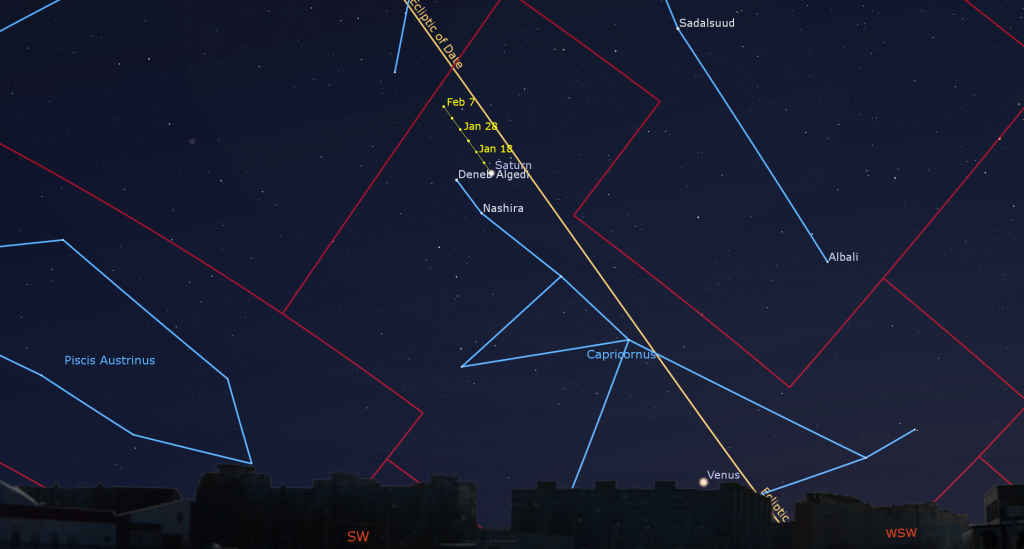
Saturn will set at around 7:30 pm local time. Its lower sky position will make seeing details through a telescope harder, but even a small telescope can show the planet’s globe encircled by its glorious rings. See if you can make out the Cassini Division, a narrow, dark gap that separates Saturn’s main inner ring (named B) from its bright outer ring (named A). A small telescope can also pick up several of Saturn’s moons – especially its largest, brightest moon, Titan! From here on Earth, Saturn’s axial tilt of 26.7° lets us see the top of its ring plane, and allows its brighter moons to array themselves all around the planet. (In contrast with Saturn, Jupiter’s axis is only tilted by 3°, so Jupiter’s moons show in a line running through that planet’s equator.) How many of the moons can you see in your telescope?
You’ve got much more time to enjoy Jupiter and Mars. Bright, white, magnitude -2.3 Jupiter, 18 times brighter than Saturn, will pop into view in the southern sky well before Venus sets. Once the sky has fully darkened, use binoculars to look for a circlet of faint stars centred a fist’s diameter to the right of Jupiter. That’s the western head of Pisces (the Fishes). The four bright corner stars of the Great Square of Pegasus will shine above them.
Your binoculars should be able to show Jupiter as a small disk bracketed by its line of four Galilean moons named Io, Europa, Ganymede, and Callisto. Those moons complete orbits of the planet every 1.7, 3.6, 7.2, and 16.7 days, respectively. If you see fewer than four moons, then one or more of them is crossing in front of or behind Jupiter, or hiding in Jupiter’s dark shadow – or two of the moons are very close together or occulting one another. The moons’ arrangement varies each night.
Jupiter will look best in a telescope while it is highest in the southern sky after dusk. It will sink lower through the evening and set in the west around 11 pm local time. Even a small, but decent quality telescope can show you Jupiter’s dark belts and light bands, which are aligned parallel to its equator. With a better grade of optics, Jupiter’s Great Red Spot, a cyclonic storm that has raged for hundreds of years, becomes visible for several hours when it crosses the planet every 2nd or 3rd night. For observers in the Americas, that GRS will cross Jupiter’s disk in early evening on Tuesday, Thursday, and Sunday, and late on Monday, Wednesday, and Saturday evening. If you have any coloured filters or nebula filters for your telescope, try enhancing the spot with them.
The round, black shadows of Jupiter’s Galilean moons are visible through a good backyard telescope when they cross the planet’s disk. On Monday evening, January 9 the small shadow of Io will cross the equator of the planet, accompanied by the GRS, from 8:20 pm to 10:28 pm EST. On Thursday evening, Europa’s tiny shadow will cross from 7:35 pm to 9:53 pm EST. The events are widely visible over the western hemisphere. Just adjust these quoted times into your own time zone.
In mid-evening this week, tiny, blue, magnitude 7.9 Neptune will be located a slim fist’s width to the lower right (or 9° to the celestial west-southwest) of Jupiter, about half way towards the medium-bright star Hydor (Lambda Aquarii). Try to view Neptune while it is highest, right after dusk. The large asteroid designated (4) Vesta is in the same region as Jupiter and Neptune. This week it will slide closely past the medium-bright trio of stars named Psi Aquarii.
Mars has definitely lost its lustre since last month’s bright opposition. Its reddish, magnitude -0.96 dot will continue to be visible all night long. During early evening it will be positioned high in the southeastern sky above the very bright, reddish star Aldebaran, which marks the angry eye of Taurus (the Bull) and to the lower left of the Pleiades star cluster. Mars will climb very high in the south around 9:30 pm local time (its absolute best telescope viewing time), and then descend westward, allowing early risers to spot it above the western horizon before dawn. Mars has been travelling towards the Pleiades. On Thursday, January 12, Mars will cease its westward motion through the stars of northern Taurus, ending a retrograde loop that began in late October. From this point on, Mars will ramp up its regular easterly prograde motion above Aldebaran, and move farther away from the Pleiades.
In backyard telescopes this week, Mars will show an apparent disk diameter of 14 arc-seconds (Jupiter’s disk spans about 38 arc-seconds and the full moon is 1,800 arc-seconds wide). Mars’ Earth-facing hemisphere this week will display its bright northern polar cap – visible as a small bright spot along the planet’s edge, and some dark regions. To identify them, you can use a terrific Mars mapping tool created by Ade Ashford at http://www.nightskies.net/skyguide/mars/mars.html. Use the drop-down menu to select from two views of Mars, labelled or not. Mars takes about 20 minutes longer than Earth to rotate once fully on its axis. So viewing the planet at the same time on consecutive nights will show roughly the same view of it – but with its surface markings shifted by about 5°. If you have coloured filters for your telescope, see if the blue, orange, or red one improves the view.
The distant blue-green planet Uranus is located about one-third of the way from Mars towards Jupiter, and about 1.5 fist widths to the right (or 15° to the celestial west-southwest) of the Pleiades star cluster. Closer guideposts to Uranus are several medium-bright stars, including Botein (or Delta Arietis), Al Butain II (or Rho Arietis), and Sigma Arietis, which will appear several finger widths from the planet. Those stars mark the feet of the Aries (the Ram). Magnitude 5.7 Uranus will already be high enough for telescope-viewing, in the middle part of the eastern sky, after dusk this week. It will climb to its highest point in the southern sky around 7:30 pm local time.
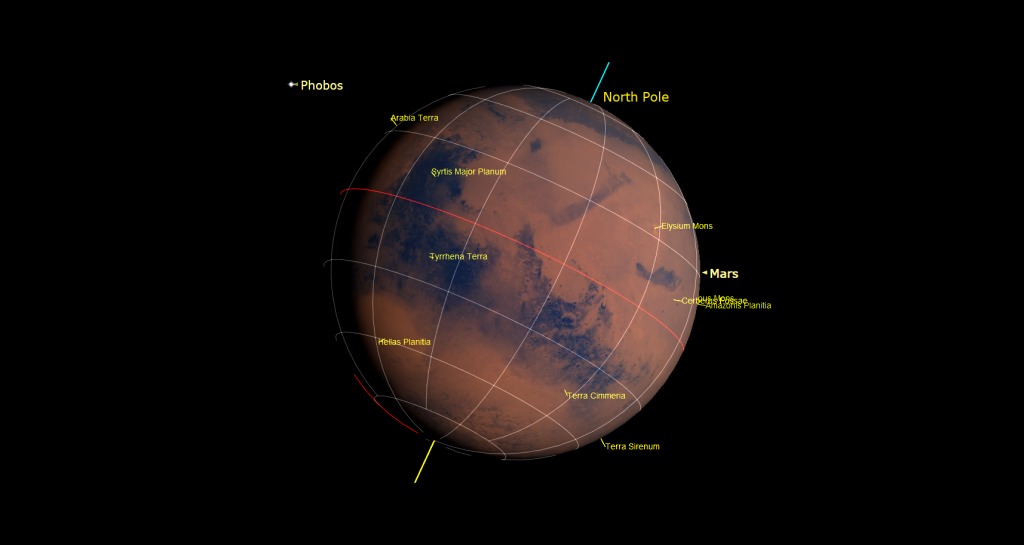
On Sunday, January 8, the main belt asteroid designated (2) Pallas will reach opposition. On the nights near opposition, Pallas will rise at sunset and set at sunrise, and shine with a visual magnitude of 7.7. That’s within reach of binoculars and backyard telescopes – but wait until the asteroid has risen higher in late evening for the best views of it. On opposition night, Pallas will be situated in southern Canis Major (the Big Dog), several finger widths to the lower right (or 3 degrees to the celestial southwest) of the bright star Adhara, and just a finger’s width above the medium-bright star Kappa Canis Majoris. On the following nights the asteroid will slide upwards (northwest). The asteroid will be easiest to observer when it’s highest, around midnight local time.
Mercury has joined the eastern pre-dawn sky, where it will become easier to spot with each passing morning. The best time to search for its magnitude 1.1 dot at mid-northern latitudes will be just before 7:15 am local time.
Public Astro-Themed Events
Every Monday evening, York University’s Allan I. Carswell Observatory runs an online star party – broadcasting views from four telescopes/cameras, answering viewer questions, and taking requests! Details are here. They host in-person viewing on the first clear Wednesday night each month. On Wednesdays they stream views online via the observatory YouTube channel. Details are here.
My free, family-friendly Insider’s Guide to the Galaxy webcast with Samantha Jewett of RASC National returns on Tuesday, January 17 at 3:30 pm EST. We’ll highlight the best celestial events of 2023, and we’ll highlight the next batch of RASC’s Finest NGC objects. You can find more details and the schedule of future sessions here.
Space Station Flyovers
There are no good opportunities to see the ISS (or International Space Station) gliding silently over the Greater Toronto Area this week.
Keep looking up, and enjoy the sky when you do. I love questions and requests. Send me some!